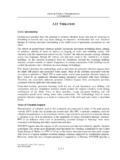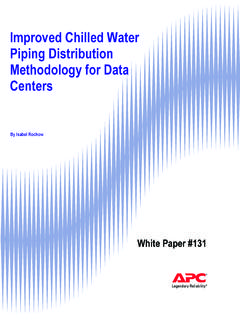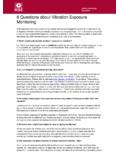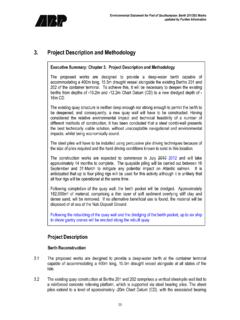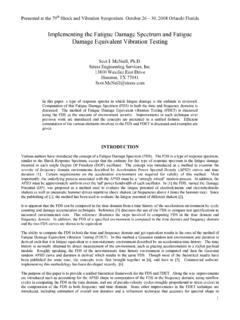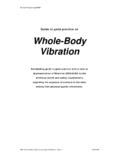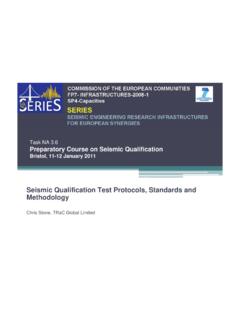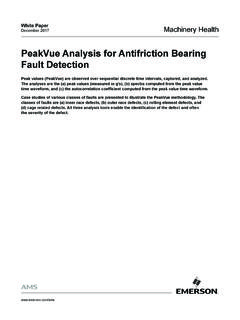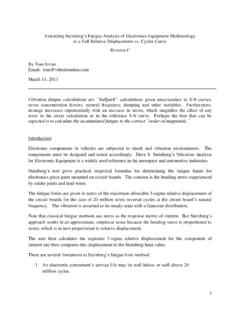Transcription of 4.13 Vibration Preferred Site - New York City
1 CHAPTER 4: Preferred SHAFT site Vibration city Tunnel No. 3, Stage 2 Manhattan Leg Shaft 33B Final EIS Vibration Introduction Construction activities have the potential to produce Vibration levels that may be annoying or disturbing to humans and may cause damage to structures. Architectural and even structural damage to existing structures surrounding a site could occur if appropriate precautions are not taken. The effects of ground-borne Vibration include discernable movement of building floors, rattling of windows, shaking of items on shelves or hanging on walls, and rumbling sounds.
2 The Vibration from the construction-related activity excites the adjacent ground, creating Vibration waves that propagate through the various soil and rock strata to the foundations of nearby buildings. As the Vibration propagates from the foundation through the remaining building structure, certain resonant, or natural, frequencies of various components of the building may be excited. In extreme cases, Vibration can cause damage to buildings. This Section describes existing Vibration conditions in the vicinity of the Preferred Shaft site and assesses the potential for construction at the Preferred Shaft site to result in Vibration impacts. The methodology used to prepare this Section is described in Section , Vibration , of Chapter 3, Impact Methodologies.
3 Existing Conditions An ambient Vibration survey was conducted to establish the baseline Vibration levels at the Preferred Shaft site from traffic traveling over the Queensboro Bridge (Bridge). As further explained in Section , Vibration , of Chapter 3, Impact Methodologies this was necessary to determine whether there would be cumulative Vibration effects with the shaft construction activities. Ambient measurements were taken at four locations on June 20 and/or June 22, 2005. Vibration levels are provided in Peak Particle Velocity (PPV) measured in inches per second (ips). As shown in Figure , Vibration monitoring locations were: Location 1: At base of the Bridge next to Preferred Shaft site . Location 2: On lower Bridge deck above Preferred Shaft site .
4 Location 3: At a residence (ground floor locksmith) directly across E. 59th Street from Preferred Shaft site . Location 4: At a multi-family residential building on the southeast corner of E. 59th Street and First Avenue. The ambient Vibration levels in the locations monitored were generally within the range of to ips. Occasional spikes were observed as a result of normal construction activities (interior Instrument LocationsEAST 59TH BRIDGE11 NYCDOT ACCESSWAY WATER MAIN CONNECTIONSHAFTRISERRISERDISTRIBUTIONCHA MBERFIGURE MEASUREMENT LOCATIONSNNOT TO SCALEL egend: site BoundaryCurblineCofferdamInstrument LocationsBuilding LineMulti-Use AreaNEW york city DEPARTMENT OF ENVIRONMENTAL PROTECTIONPROPOSED SHAFT 33B TO city WATER TUNNEL NO. 3 STAGE 2-MANHATTAN LEGPREFERRED SHAFT SITECHAPTER 4: Preferred SHAFT site Vibration city Tunnel No.)
5 3, Stage 2 Manhattan Leg Shaft 33B Final EIS remodeling near Location 3) and truck traffic. The spikes observed during the monitoring program were all below ips. In general, vibrations at the lower Bridge deck (Location 2) were the highest. The results of the Vibration monitoring show that existing Vibration levels are negligible and would not result in cumulative Vibration effects with those of the project that would affect the impact criteria for structural damage or procedures for the proposed construction activities. Future Conditions Without the Project None of the projects identified for development between 2006 and 2012 would be expected to introduce significant Vibration levels in the Study Area.
6 Therefore, Vibration levels would be expected to be comparable to those currently existing in the vicinity of the Preferred Shaft site . Future Conditions With the Project Construction Overview Controlled blasting, pavement breaking (including jack hammers), rock drilling, soil compaction, and pile installation would produce the highest Vibration levels during construction of the Preferred Shaft site . Blasting is discussed first, followed by a discussion of other construction activities at the site . There are no substantive differences between the base configuration and alternate site configuration with regard to Vibration impacts and, therefore, the assessment provided below would apply to both. The assessment below discusses protective measures that would be implemented to avoid potential construction-related Vibration impacts at the Preferred Shaft site .
7 A discussion of special protection measures that will be put in place to protect historic structures is also provided. A detailed Vibration control plan that will include the measures discussed below will be developed by the construction contractor prior to construction. The plan will include a Vibration monitoring program to be implemented during construction. The detailed Vibration plan will account for specific geological conditions, foundation assessment of structures near Vibration -causing construction activities, and the appropriateness of the Vibration thresholds to affected buildings. Finally, the detailed plan will include specific measures and best management practices to avoid potential Vibration impacts. In advance of certain activities that are likely to result in high Vibration levels such as blasting, NYCDEP and its contractor would conduct extensive outreach to those in the vicinity of the Preferred Shaft site that could be affected.
8 This would include providing the nearby community with the expected start date for blasting operations, the general time pattern during the ensuing months, and the timing and significance of the warning whistles. CHAPTER 4: Preferred SHAFT site Vibration city Tunnel No. 3, Stage 2 Manhattan Leg Shaft 33B Final EIS Finally, NYCDEP would not permit construction activities to occur between 11:00 and 7:00 with the exception of the 3 months of continuous (24 hours per day and 7 days per week) raise boring activities. Blasting Of the construction activities proposed, blasting would result in the highest potential Vibration levels.
9 Blasting would be necessary at the Preferred Shaft site to enlarge the shaft and form the distribution chamber at the top of the shaft. Blasting would not occur at the ground surface since the bedrock at the site is more than 20 feet below the ground surface. Blasting would be expected to occur for roughly eight months. Depending on the procedures employed, the timing of rock removal, and other considerations, blasting could occur on a daily or less frequent than daily basis over this eight month period. Vibration levels associated with blasting are dependent on the amount of explosive used, geological conditions between the blast site and the receptor, and the fact that blasting will take place at least 20 feet below the surface. NYCDEP will implement the protective measures described below, including monitoring and control measures, to minimize or avoid Vibration effects.
10 These measures will primarily address potential structural or architectural damage. Human annoyance Vibration thresholds are much lower than structural or architectural damage criteria, and Vibration levels from blasting could be at levels annoying or disturbing to humans. As part of developing the detailed Vibration control plan discussed above, a blasting/ Vibration expert would be retained by the contractor to evaluate and optimize the blasting procedure. This process would involve detailed analysis of shaft geometry, geology, and relative locations of sensitive structures, and determination of likely blasting procedures and resulting Vibration levels. Analyses would be performed to determine the maximum Vibration levels that would be expected at specific locations due to construction activities.










